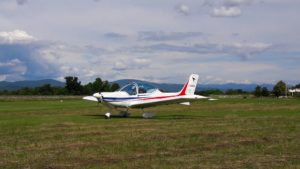Fly SYnthesis Texan Top Class
Il Texan è una pietra miliare nel mondo VDS, arcinoto come “padre di famiglia”, stabile, ma anche dotato di una buona manovrabilità e di ottime prestazioni di atterraggio e decollo corto.
La versione Top Class del 2006 ha finiture, comfort ed equipaggiamenti a livello di aviazione generale, a prezzo di qualche kg in più (possibile grazie alle normative LSA o ultralight avanzato applicate in molti paesi esteri, tra cui Israele), che a mio avviso snatura il concetto originale del Texan, ovvero un gran navigatore con prestazioni STOL, portandolo verso l’inerzia tipica degli AG.
Il Texan 2.0 è caratterizzato da una maggior rifinitura aerodinamica in particolare nella zona di raccordo della radice alare, oltre che del cofano motore, consentendo una crociera al 70% della potenza di 120 kts a pieno carico (600 Kg) e consumi decisamente inferiori.
Che si voli a 130 kts, o a 50 kts, il velivolo trasmette sempre la medesima sensazione di fiducia.
La risposta dei comandi, in tutti gli assetti, è fluida e scattante. E il vano bagagli questa volta, grazie al nuovo carico utile (i 15 kg del paracadute sono stati spostati in avanti), non ha posto alcun limite se non quello delle dimensioni del bagaglio a mano per il ritorno con la linea.
E poi la stabilità: 18 ore di volo in tre giorni senza usare l’autopilota e senza sentire la stanchezza, mi sembrano più che sufficienti per descriverla, senza dimenticare il comportamento in turbolenza, sano e sicuro.
Se dovessi descrivere il Texan 2.0 con un paragone automobilistico direi che è un SUV di carattere sportivo con dotazione full optional: si viaggia comodi e si arriva dappertutto.
Fonte: Rivista VoloSportivo Marzo 2015, articolo di Aimaro Agostino
Caratteristiche generali
- Equipaggio: 1 pilota
- Capacità: 1+1
- Lunghezza: 6,99 m
- Apertura alare: 8,60 m
- Altezza: 2,40 m
- Superficie alare: 11,8 m2
- Peso a vuoto: kg 315
- Peso massimo al decollo: 600 kg
- Gruppo motopropulsore: 1 × Rotax 912 ULS
Prestazioni
- VNE: 250 km/h (135 kts)
- Velocità massima: 200 km/h al livello del mare (108 kts)
- Velocità di crociera: 145 km/h (78 kts)
- Velocità di stallo: 74 km/h (40 kts)
- Corsa di decollo: 125 metri
- Distanza di atterraggio: 275 metri
Per scaricare il manuale di volo in pdf cliccare qui .
The Texan is a milestone in the VDS world, well-known as a “family man”, stable, but also with good maneuverability and excellent landing and short take-off performance.
The 2006 Top Class version has finishes, comfort and equipment at the general aviation level, at a price of a few kg more (possible thanks to the LSA or advanced ultralight regulations applied in many foreign countries, including Israel), which in my opinion distorts the original concept of the Texan, that is a great navigator with STOL performances, bringing it towards the typical inertia of AGs.
The Texan 2.0 is characterized by a greater aerodynamic finish in particular in the connection area of the wing root, as well as in the bonnet, allowing a cruise at 70% of the power of 120 kts at full load (600 Kg) and decidedly lower consumption.
Whether flying at 130 kts, or 50 kts, the aircraft always conveys the same feeling of confidence.
The response of the commands, in all settings, is fluid and snappy. And the luggage compartment this time, thanks to the new payload (the 15 kg of the parachute has been moved forward), has set no limit other than the size of the hand luggage for the return with the line.
And then stability: 18 hours of flight in three days without using the autopilot and without feeling tired, seem more than enough to describe it, without forgetting the behavior in turbulence, healthy and safe.
If I had to describe the Texan 2.0 with an automotive comparison I would say that it is a sporty SUV with full optional equipment: you can travel comfortably and you can get anywhere.
Source: VoloSportivo magazine March 2015, article by Aimaro Agostino(SWISS BUNNY)
General characteristics
Crew: 1 pilot
Capacity: 1+1
Length: 6.99 m
Wingspan: 8.60 m
Height: 2.40 m
Wing area: 11.8 m2
Empty weight: 315 kg
Maximum take-off weight: 600 kg
Powertrain: 1 × Rotax 912 ULS
Performance
VNE: 250 km / h (135 kts)
Maximum speed: 200 km / h at sea level (108 kts)
Cruising speed: 145 km / h (78 kts)
Stall speed: 74 km / h (40 kts)
Take-off run: 125 meters
Landing distance: 275 meters









 Vieni a provare l'emozione del volo! Ci trovi
all'Aviosuperficie di San Mauro di Premariacco (UD), rilassati nel
verde del nostro giardino, ai bordi della piscina oppure seduto ai
tavolini del bar/ristorante con vista sulla pista. Se vuoi, puoi
provare il brivido del battesimo del volo: accompagnato dai nostri
migliori piloti, - magari insieme alla tua famiglia o ai tuoi amici.
Per maggiori informazioni contattateci al numero
392 874 8926 oppure all'indirizzo mail
Vieni a provare l'emozione del volo! Ci trovi
all'Aviosuperficie di San Mauro di Premariacco (UD), rilassati nel
verde del nostro giardino, ai bordi della piscina oppure seduto ai
tavolini del bar/ristorante con vista sulla pista. Se vuoi, puoi
provare il brivido del battesimo del volo: accompagnato dai nostri
migliori piloti, - magari insieme alla tua famiglia o ai tuoi amici.
Per maggiori informazioni contattateci al numero
392 874 8926 oppure all'indirizzo mail